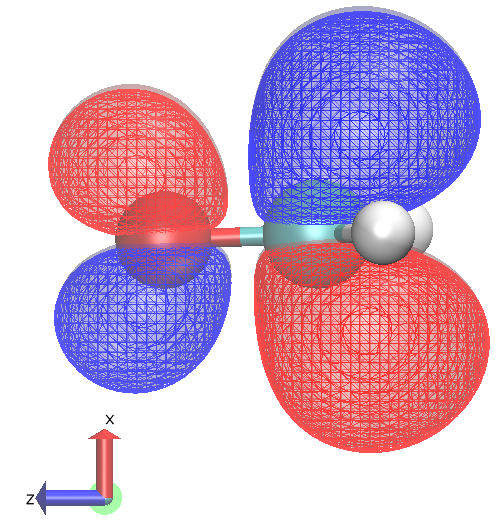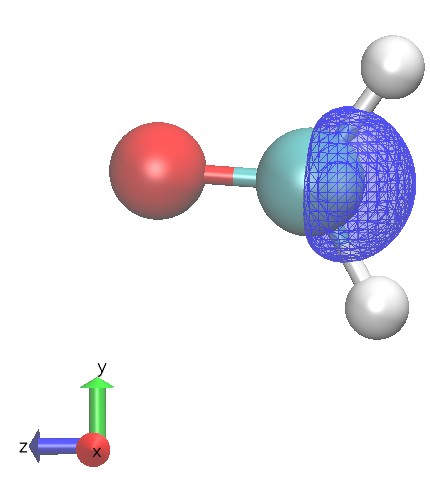Lincoln is here¶
 |  |  |
Why are we interested in excited states?¶
- Photochemistry
- Photocatalysis
- Energy conversion
- Solar cells
- Spectroscopy
TDDFT¶
DFT normally thought of as ground state theory.
But, time dependent version actually has quite long history - it didn't really achieve prominence until Casida's reformulation caught on with Quantum Chemistry community.
TDDFT solves the time-dependent Kohn-Sham equations. If the system is responding to the perturbation caused by an electric field, then we can extract the optical properties of the system from the response.
Two main methods to determine this response by solving the TDKS equations
- Linear-response Time Dependent Density Functional Perturbation Theory
- Real time propagation
both methods are available in CP2K.
Runge-Gross theorem¶
The time-dependent counterparts of the Hohenberg-Kohn theorems is the Runge-Gross theorem
By solving the Schrodinger equation for external potentials $V(t)$ and a fixed initial state we can map an external potential to a charge density
the Runge-Gross theorem says that this map is invertible (subject to some conditions that are still being refined):
$$ G^{-1}:n(r,t) \rightarrow v(r,t) + C(t) $$
This means that the density of a time-dependent system determines the time-dependent potential, which in turn determines the time-dependent wavefunction: every physically meaningful property can be regarded as a functional of the density.
(we ignore the purely time-dependent function $C(t)$ as it only introduces a physically unimportant phase-factor $\bar{\Psi}(t) = e^{-i \alpha (t)}\Psi(t)$, where $\dot{\alpha}(t) = C(t)$)
Action functional¶
The equivalent of the energy functional $E[n]$ of a time-independent system for a time-dependent system is
$$ A[n] = \int_{t_0}^{t_1} \text{d}t \left< \Psi[n](t)\big{|} i\frac{\partial}{\partial t} - H(t) \big{|} \Psi[n](t) \right> $$The exact time-dependent density is a stationary point of this functional
$$ \frac{\partial A}{\partial n(t)} = 0 $$How to approximate $A_{XC}[n]$?¶
Just use the same functional of the density as ground state DFT, but use the density at the current time.
Adiabatic local density approximation (ALDA)¶
if we don't know much about the exchange correlation functional, we know even less about the time dependent action functional.
The normal approach is to use the ALDA
it is memoryless - response doesn't depend on history, and local.
We use a standard density functional evaluated with the current ground state density.
Almost universal approach at the moment - some research on current / memory functionals
Time dependent Kohn-Sham equations¶
at this point we can introduce one-electron orbitals and obtain the equivalent of the KS-DFT equations.
The time-dependent density is
$$ n(r,t) = \sum_{i \in HOMOs}\psi_i(r,t)^* \psi_i (r,t) $$we find the appropriate density by the condition
$$ \frac{\delta A}{\delta n(t)} = 0 $$and after a bit of work we get
$$ \big{[} -\frac{1}{2}\nabla^2 + v_s[n](r,t) \big{]} \psi_i(t) = i \frac{\partial \psi_i(t)}{\partial t} $$with the effective potential
$$ v_s[n](r,t) = \int_r' \text{d}r'\frac{n(r',t)}{\mid r' - r\mid} + v(r,t)+ \frac{\delta A_{XC}[n]}{\delta n} $$all that needs to be done is to solve the equations given a set $\psi_i(r,t_0)$.
Matrix equations¶
Skipping quite a bit -
because the response orbitals should be orthogonal to the ground state orbitals we expand them as a linear combination of LUMOs
$$ \psi_{i, \sigma}^{(\pm)}(r) = \sum_{j \in LUMOs} c_{i,j, \sigma}\psi_{j,\sigma} (r) $$Electron hole pairs¶
The transition density is a linear combination of $\color{red}{electron}-\color{blue}{hole}$ pairs
\begin{gather*} \left ( \color{blue}{\psi_{j,\sigma}^*} (r) \color{red}{\psi_{j,\sigma}^{(-)}(r)} + \color{red}{\psi_{j,\sigma}^{(-)*}(r)}\color{blue}{ \psi_{j,\sigma}(r)} \right) e^{-i \omega t} \end{gather*}in the ground state the $\psi_{j,\sigma}$ function would be fully occupied, but here density has be transferred to $\psi_{j,\sigma}^{(-)}(r)$ .
$\color{blue}{\psi_{j,\sigma} (r) }$ is the hole, $\color{red}{\psi_{j,\sigma}^{(-)}(r)}$ the electron.
The sum over all the HOMOs allows the hole to relax by mixing in other occupied orbitals.
Each of the terms in the sum are single determinant excitation in Quantum Chemical language.
Typical transitions will be dominated by a single determinant - mixing of others gives orbital relaxation.
Using the same basis of contracted Gaussian functions as for the ground state, we finally get
\begin{gather*} \sum_{\nu} \big{(} \mathbf{F_{\nu \mu \sigma}} c_{\mu j \sigma}^{(-)} - \mathbf{S_{\nu \mu} c_{\mu j \sigma}^{(-)} \epsilon_{j \sigma}}\big{)} + \\ \sum_{\nu} \sum_{\gamma} \big{(} \delta_{\mu \gamma} - \sum_k \sum_{\delta} \mathbf{S_{\mu \delta }} c_{\delta k \sigma}^{(0)} c_{\gamma k \sigma}^{(0)} \big{)} \mathbf{K_{\gamma \nu \sigma}} c_{\nu j \sigma}^{(0)} = \omega \sum \mathbf{S_{\nu \mu \sigma}}c_{\mu j \sigma}^{(-)} \end{gather*}where
$$ \mathbf{F_{\nu \mu \sigma}} = \big{<} \phi_{\nu} \big{|} H^{(0)}_{\sigma}\big{|} \phi_{\mu} \big{>} $$is the ground state KS matrix
and
$$ \mathbf{K_{\nu \mu \sigma}} = \big{<} \phi_{\nu} \big{|} \sum_{\tau=\alpha, \beta} \big{[} \int_{r'} \text{d}r' \frac{n_{j, \tau}^{(1)} (r')}{\mid r' - r\mid} + f_{XC,\sigma,\tau} (r,r';\pm \omega)) n_{j, \tau}^{(1)} (r') \big{]} \big{|} \phi_{\mu} \big{>} $$is the TDDFPT Kernel for a semi-local density function.
For hybrid functionals we add in an extra coulomb type term that comes from the response of the exact exchange part of the functional.
Tamm-Dancoff approximation¶
only the Tamm-Dancoff approximation to TDDFT is implemented in CP2K at the moment.
In this approximation $\phi^{(+)}_{j\sigma} (r) = 0$ and the equations simplify and become Hermitian.
Hybrid functionals¶
For hybrid functionals we add in an extra term that comes from the response of the exact exchange part of the functional.
With hybrid density functionals the original action functional becomes a mixture of the TDDFT outlined above and TDHF.
- The coulomb interaction in standard functionals actually becomes an exchange like term, dependent on wavefunction overlap between the electron and hole.
Semi-local functionals have incorrect long-range behaviour because of this - well known underestimation of charge transfer states.
- the exact exchange energy term in the ground state functional becomes a coulomb type interaction between the electron and hole density for each excitation.
where the symbolic $\color{green}{K(r,r')}$ operator exchanges electrons, like in HF theory. In this case operating on an exchange type term, it gives an electron-hole coulomb interaction. Symbollically, terms of the form:
$$ \color{green}{ \big<\psi_{HOMOS} (r) \psi_{HOMOS} (r) \big| { \frac{1}{\mid r' - r\mid}} \big| \psi_{LUMOS} (r') \psi_{LUMOS} (r') \big> } $$Note this is like a coloumb interaction screened by an effective dielectric function equal to $\color{green}{c_{HF}^{-1}}$.
Implementation¶
We followed the original implementation of TDDFPT for semi-local functionals within CP2K (Thomas Chaissang's PhD thesis). But, ended up with complete rewrite.
Currently separate implementation (TDDFPT2). Original is deprecated, and will be removed in future.
It is activated within the
&PROPERTIESsection of&FORCE_EVAL- so can be used within MD or MC or single point calcs etc.XCsection is inherited from the ground state calc - needs weak smoothingSPLINE2_SMOOTHon the XC gradients.
Uses a standard block Davidson algorithm for iterative diagonalization of excited states.
- Semi-local DFT terms are calculated on realspace multigrids
- Because of the exchange, this is not possible for the added exact exchange term with iterative diagonalisation: Hybrid term is calculated analytically using the existing hybrid functional routines in CP2K
- including access to fast methods like ADMM. (x1000 speed up for some basis sets)
Oscillator strengths calculated using the velocity operator form of the dipole interaction - which can be translated into a term related to the derivative of the overlap matrix (similar to force calculation in local basis set codes).
- should be valid in periodic systems (scarcely tested though)
- might be subject to noise in some cases
Extra layer of parallelism over excitations is available, but may have too high initial communication overhead to be viable - to be continued...
Input files¶
Here is an example input for formaldehyde (CH$_2$O)
The TDDFPT calculation is activated by the &PROPERITIES section. And doesn't need to much messing with.
This needs a very up-to-date version of CP2K (like the default on ARCHER!)
Here we calculate 3 excited states.
&GLOBAL
PROJECT ch2o_pbe0_rks_s_tddfpt
RUN_TYPE energy
PRINT_LEVEL medium
&END GLOBAL
&FORCE_EVAL METHOD Quickstep
&PROPERTIES
&TDDFPT
NSTATES 3 # number of excited states
MAX_ITER 10 # maximum number of Davidson iterations
CONVERGENCE [eV] 1.0e-3 # convergence on maximum energy change between iterations
&MGRID
CUTOFF 200 # separate cutoff for TDDFPT calc
&END
&END TDDFPT
&END PROPERTIES
&DFT
BASIS_SET_FILE_NAME GTH_BASIS_SETS
POTENTIAL_FILE_NAME POTENTIAL
&MGRID
CUTOFF 400
&END MGRID
&QS
METHOD gpw
&END QS
&SCF
MAX_SCF 30
EPS_SCF 1e-7
SCF_GUESS atomic
&END SCF
&POISSON
PERIODIC none
POISSON_SOLVER wavelet
&END POISSON
&XC
&XC_FUNCTIONAL pbe0
&END XC_FUNCTIONAL
&XC_GRID
XC_DERIV SPLINE2_SMOOTH # this is needed for the 2nd derivatives of the XC functional
&END XC_GRID
&HF
&SCREENING
EPS_SCHWARZ 1.0E-10
&END SCREENING
&END HF
&END XC
&END DFT
&SUBSYS
&TOPOLOGY
&CENTER_COORDINATES
&END CENTER_COORDINATES
&END TOPOLOGY
&CELL
ABC 9.0 9.0 9.0
PERIODIC NONE
&END CELL
&COORD
O 0.9588431900 1.1234806613 1.8643358699
C 1.0045827842 1.0372747429 0.6713062328
H 1.0304990091 1.9328340670 0.0202209074
H 1.0234151411 0.0574091066 0.1554705073
&END COORD
&KIND O
BASIS_SET aug-TZV2P-GTH
POTENTIAL GTH-PBE-q6
&END KIND
&KIND C
BASIS_SET aug-TZV2P-GTH
POTENTIAL GTH-PBE-q4
&END KIND
&KIND H
BASIS_SET aug-TZV2P-GTH
POTENTIAL GTH-PBE-q1
&END KIND
&END SUBSYS
&END FORCE_EVAL
</code>
After the ground state calculation you should see something like
TDDFPT WAVEFUNCTION OPTIMIZATION
Step Time Convergence Conv. states
1 1.3 1.1524E-02 0
2 1.4 1.1928E-03 0
3 1.4 1.0624E-03 2
4 1.4 4.0385E-05 2
5 1.3 5.0590E-07 3
Restart Davidson iterations
6 1.3 8.9465E-05 1
7 1.3 2.1614E-09 3
and when it converges
*** TDDFPT run converged in 7 iteration(s) ***
R-TDDFPT states of multiplicity 1
State Excitation Transition dipole (a.u.) Oscillator
number energy (eV) x y z strength (a.u.)
TDDFPT| 1 3.83726 -0.0000 0.0000 -0.0000 0.00000
TDDFPT| 2 5.84022 0.0008 0.3265 -0.0000 0.01526
TDDFPT| 3 6.59404 0.0338 -0.0001 0.3225 0.01699
Excitation analysis
State Occupied Virtual Excitation
number orbital orbital amplitude
1
6 7 -0.999718
2
6 8 -0.997564
3
6 9 -0.996738
6 16 -0.052845
The 'occupied' and 'virtual' orbital sections show which are the dominant contributors to a transition
Visualisation¶
orbitals can be viewed by
- outputing MO cubes
&DFT
&PRINT
&MO_CUBES
STRIDE 1 # for accurate visualisation
NHOMO x
NLUMO y
&END
&END
&END
- outputing the wavefunctions in MOLDEN format (new!) feature
- VMD can process the single MOLDEN wavefunction file to view orbitals
&SCF
&PRINT
&MOS_MOLDEN
&END
&END
&END
 |  |
HOMO to LUMO transition has no oscillator stength (not totally symmetric under 'multiplication' with 'x,y or z')
 |  |
HOMO to LUMO + 1 allowed
Linear response summary¶
- gives electron transitions and detailed information on the types of transition
- cost will depend on system size, but increase linearly with the number of excited states that you want to calculate
- supports calculations using hybrid functionals and the ADMM approximation
- current implementation is very much in beta, but is being actively developed.
- nearly production ready, needs final testing and refining - is available in trunk via sourceforge or github
Excited state forces¶
Currently only energies with LR-TDDFTPT.
Two options
Ehrenfest dynamics - see Samuel Andermatt, Jinwoong Cha, Florian Schiffmann, and Joost VandeVondele, J. Chem. Theory Comput., 2016, 12, pp 3214–3227 DOI: 10.1021/acs.jctc.6b00398
Maximum Overlap Method - systems constrained to single excited state determinant calculated self consistently (delta-SCF) method - see Andrew T. B. Gilbert, Nicholas A. Besley and Peter M. W. Gill, J. Phys. Chem. A, 2008, 112 (50), pp 13164–13171 DOI: 10.1021/jp801738f
Maximum overlap method¶
By intitially occupying a LUMO + x and deoccupying a HOMO + y orbital we can build an excited state determinant.
During the SCF cycles we calculate the projection of the new atomic orbitals onto those of the previous cycle
$$ \mathbf{O} = (\mathbf{C^{old}}) \mathbf{SC^{new}} $$When building the new density matrix, instead of following the Aufbau Principle, we occupy the $nelectron$ states most like the $nelectron$ orbitals occcupied in the previous cycle.
This is performed self consistently. When self-consistent, forces and other properties can be calculated using normal ground state routines.
Examples in regtest-mom-[12]
&SCF
MAX_SCF 40
EPS_SCF 1e-6
SCF_GUESS restart
ADDED_MOS 5
&MIXING
ALPHA 0.2
&END MIXING
&MOM on
DEOCC_ALPHA 3
OCC_ALPHA 5
&END MOM
&END SCF
MOM is activated in the SCF section.
- Must use traditional diagonalisation rather than OT
- Must have some
ADDED_MOS - Specify orbitals to occupy and deoccupy to make initial state
Thanks To¶
- Joost VondeVondele (?)
- Juerg Hutter (University of Zurich)
- Alex Shluger (UCL)
- CP2K developers
- Iain, EPCC, ARCHER
